The HRM Implications of Merger
VerifiedAdded on 2023/06/11
|12
|3617
|370
AI Summary
This paper explores the aforementioned concepts to understand their implications in Sainsbury’s and Asda merger. The paper covers leadership models, employment laws, and motivational approaches.
Contribute Materials
Your contribution can guide someone’s learning journey. Share your
documents today.
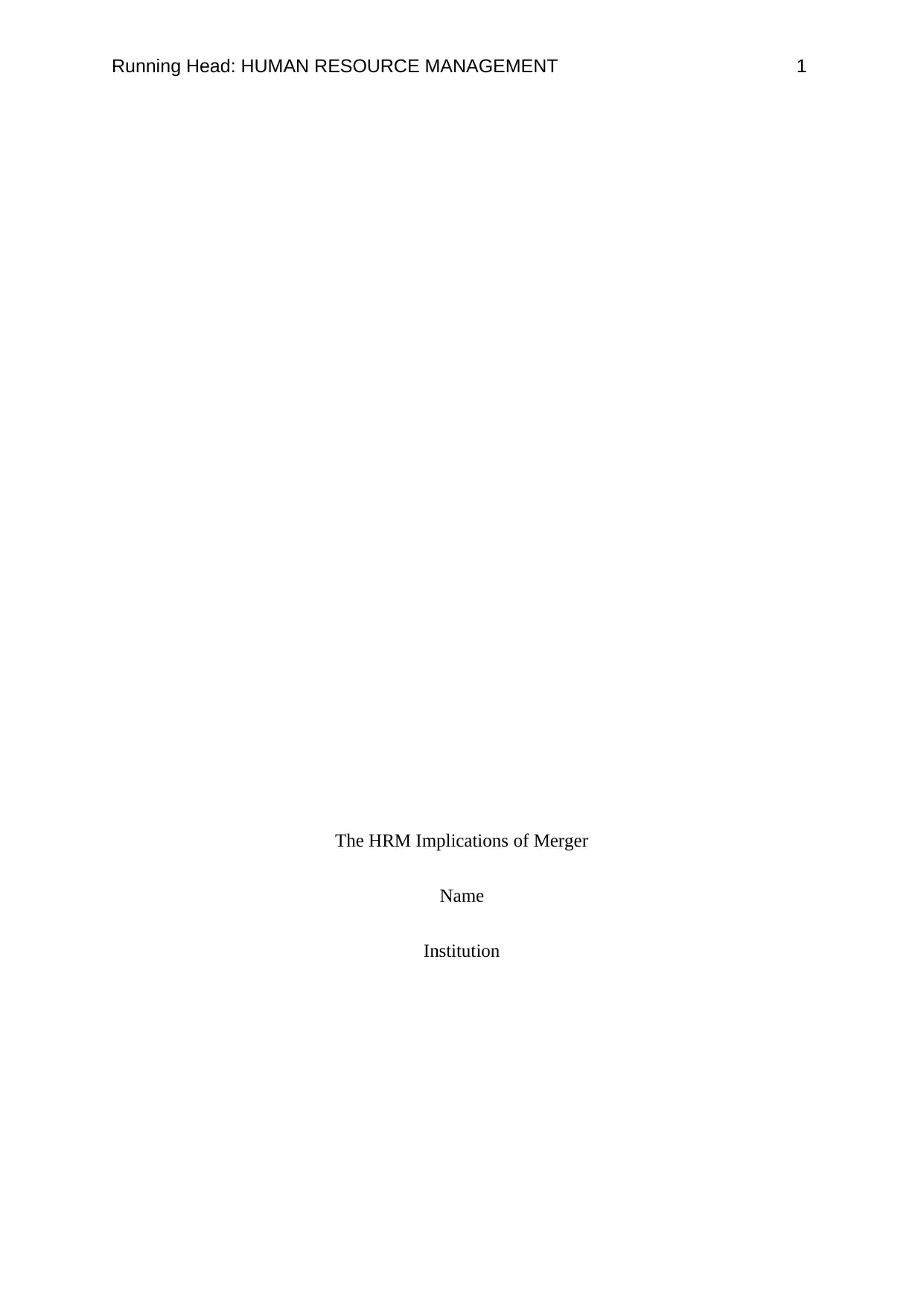
Running Head: HUMAN RESOURCE MANAGEMENT 1
The HRM Implications of Merger
Name
Institution
The HRM Implications of Merger
Name
Institution
Secure Best Marks with AI Grader
Need help grading? Try our AI Grader for instant feedback on your assignments.
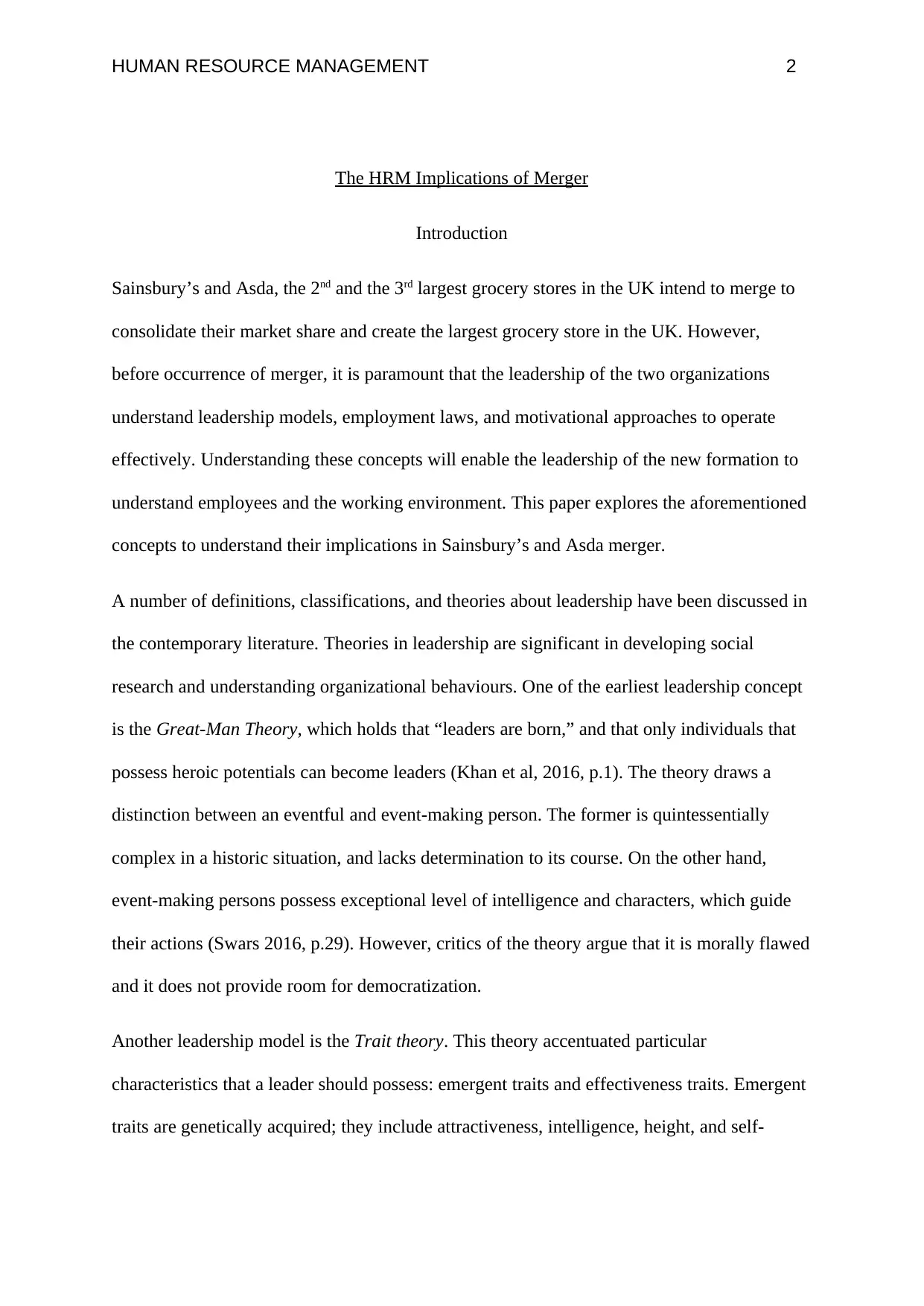
HUMAN RESOURCE MANAGEMENT 2
The HRM Implications of Merger
Introduction
Sainsbury’s and Asda, the 2nd and the 3rd largest grocery stores in the UK intend to merge to
consolidate their market share and create the largest grocery store in the UK. However,
before occurrence of merger, it is paramount that the leadership of the two organizations
understand leadership models, employment laws, and motivational approaches to operate
effectively. Understanding these concepts will enable the leadership of the new formation to
understand employees and the working environment. This paper explores the aforementioned
concepts to understand their implications in Sainsbury’s and Asda merger.
A number of definitions, classifications, and theories about leadership have been discussed in
the contemporary literature. Theories in leadership are significant in developing social
research and understanding organizational behaviours. One of the earliest leadership concept
is the Great-Man Theory, which holds that “leaders are born,” and that only individuals that
possess heroic potentials can become leaders (Khan et al, 2016, p.1). The theory draws a
distinction between an eventful and event-making person. The former is quintessentially
complex in a historic situation, and lacks determination to its course. On the other hand,
event-making persons possess exceptional level of intelligence and characters, which guide
their actions (Swars 2016, p.29). However, critics of the theory argue that it is morally flawed
and it does not provide room for democratization.
Another leadership model is the Trait theory. This theory accentuated particular
characteristics that a leader should possess: emergent traits and effectiveness traits. Emergent
traits are genetically acquired; they include attractiveness, intelligence, height, and self-
The HRM Implications of Merger
Introduction
Sainsbury’s and Asda, the 2nd and the 3rd largest grocery stores in the UK intend to merge to
consolidate their market share and create the largest grocery store in the UK. However,
before occurrence of merger, it is paramount that the leadership of the two organizations
understand leadership models, employment laws, and motivational approaches to operate
effectively. Understanding these concepts will enable the leadership of the new formation to
understand employees and the working environment. This paper explores the aforementioned
concepts to understand their implications in Sainsbury’s and Asda merger.
A number of definitions, classifications, and theories about leadership have been discussed in
the contemporary literature. Theories in leadership are significant in developing social
research and understanding organizational behaviours. One of the earliest leadership concept
is the Great-Man Theory, which holds that “leaders are born,” and that only individuals that
possess heroic potentials can become leaders (Khan et al, 2016, p.1). The theory draws a
distinction between an eventful and event-making person. The former is quintessentially
complex in a historic situation, and lacks determination to its course. On the other hand,
event-making persons possess exceptional level of intelligence and characters, which guide
their actions (Swars 2016, p.29). However, critics of the theory argue that it is morally flawed
and it does not provide room for democratization.
Another leadership model is the Trait theory. This theory accentuated particular
characteristics that a leader should possess: emergent traits and effectiveness traits. Emergent
traits are genetically acquired; they include attractiveness, intelligence, height, and self-
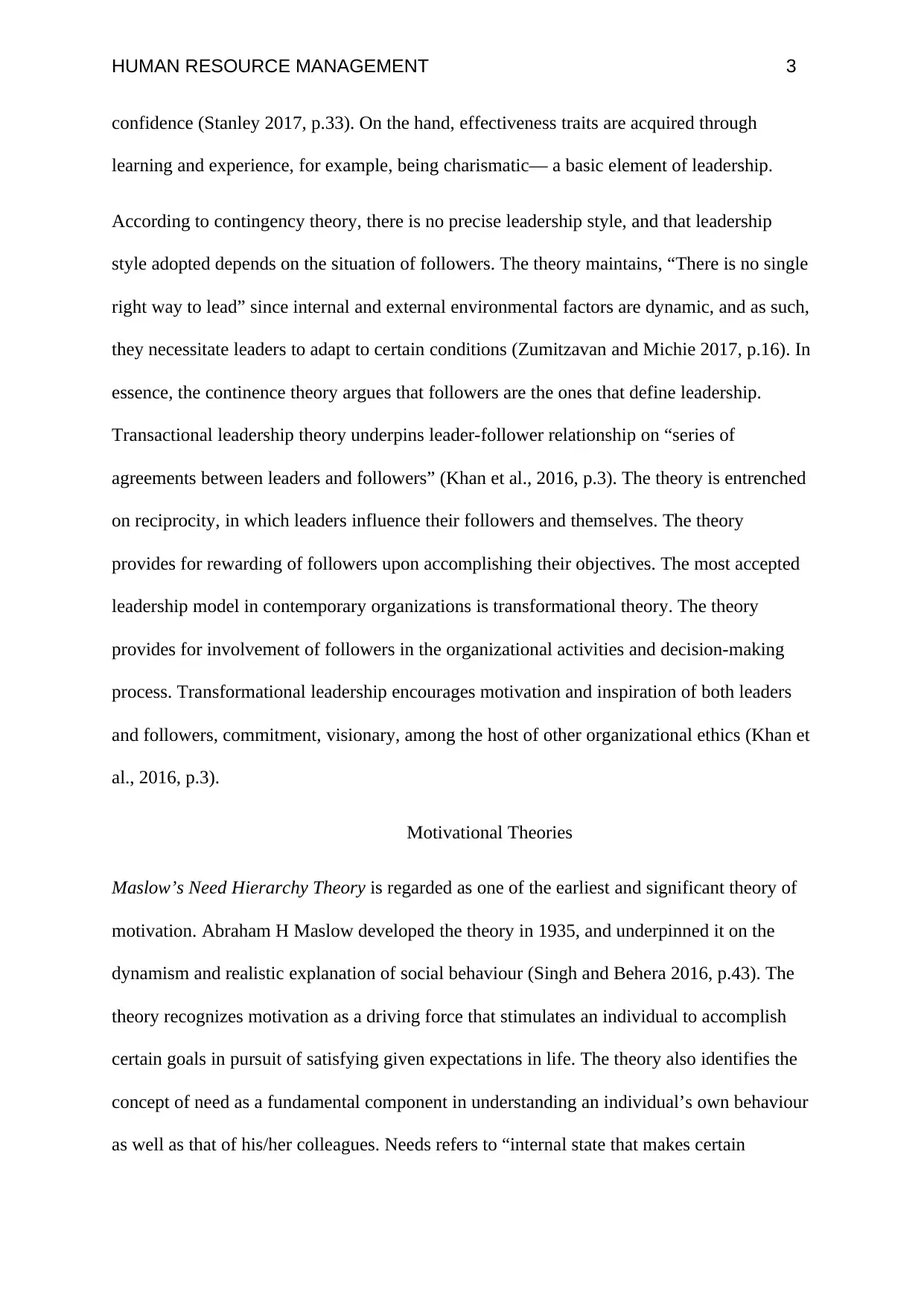
HUMAN RESOURCE MANAGEMENT 3
confidence (Stanley 2017, p.33). On the hand, effectiveness traits are acquired through
learning and experience, for example, being charismatic— a basic element of leadership.
According to contingency theory, there is no precise leadership style, and that leadership
style adopted depends on the situation of followers. The theory maintains, “There is no single
right way to lead” since internal and external environmental factors are dynamic, and as such,
they necessitate leaders to adapt to certain conditions (Zumitzavan and Michie 2017, p.16). In
essence, the continence theory argues that followers are the ones that define leadership.
Transactional leadership theory underpins leader-follower relationship on “series of
agreements between leaders and followers” (Khan et al., 2016, p.3). The theory is entrenched
on reciprocity, in which leaders influence their followers and themselves. The theory
provides for rewarding of followers upon accomplishing their objectives. The most accepted
leadership model in contemporary organizations is transformational theory. The theory
provides for involvement of followers in the organizational activities and decision-making
process. Transformational leadership encourages motivation and inspiration of both leaders
and followers, commitment, visionary, among the host of other organizational ethics (Khan et
al., 2016, p.3).
Motivational Theories
Maslow’s Need Hierarchy Theory is regarded as one of the earliest and significant theory of
motivation. Abraham H Maslow developed the theory in 1935, and underpinned it on the
dynamism and realistic explanation of social behaviour (Singh and Behera 2016, p.43). The
theory recognizes motivation as a driving force that stimulates an individual to accomplish
certain goals in pursuit of satisfying given expectations in life. The theory also identifies the
concept of need as a fundamental component in understanding an individual’s own behaviour
as well as that of his/her colleagues. Needs refers to “internal state that makes certain
confidence (Stanley 2017, p.33). On the hand, effectiveness traits are acquired through
learning and experience, for example, being charismatic— a basic element of leadership.
According to contingency theory, there is no precise leadership style, and that leadership
style adopted depends on the situation of followers. The theory maintains, “There is no single
right way to lead” since internal and external environmental factors are dynamic, and as such,
they necessitate leaders to adapt to certain conditions (Zumitzavan and Michie 2017, p.16). In
essence, the continence theory argues that followers are the ones that define leadership.
Transactional leadership theory underpins leader-follower relationship on “series of
agreements between leaders and followers” (Khan et al., 2016, p.3). The theory is entrenched
on reciprocity, in which leaders influence their followers and themselves. The theory
provides for rewarding of followers upon accomplishing their objectives. The most accepted
leadership model in contemporary organizations is transformational theory. The theory
provides for involvement of followers in the organizational activities and decision-making
process. Transformational leadership encourages motivation and inspiration of both leaders
and followers, commitment, visionary, among the host of other organizational ethics (Khan et
al., 2016, p.3).
Motivational Theories
Maslow’s Need Hierarchy Theory is regarded as one of the earliest and significant theory of
motivation. Abraham H Maslow developed the theory in 1935, and underpinned it on the
dynamism and realistic explanation of social behaviour (Singh and Behera 2016, p.43). The
theory recognizes motivation as a driving force that stimulates an individual to accomplish
certain goals in pursuit of satisfying given expectations in life. The theory also identifies the
concept of need as a fundamental component in understanding an individual’s own behaviour
as well as that of his/her colleagues. Needs refers to “internal state that makes certain
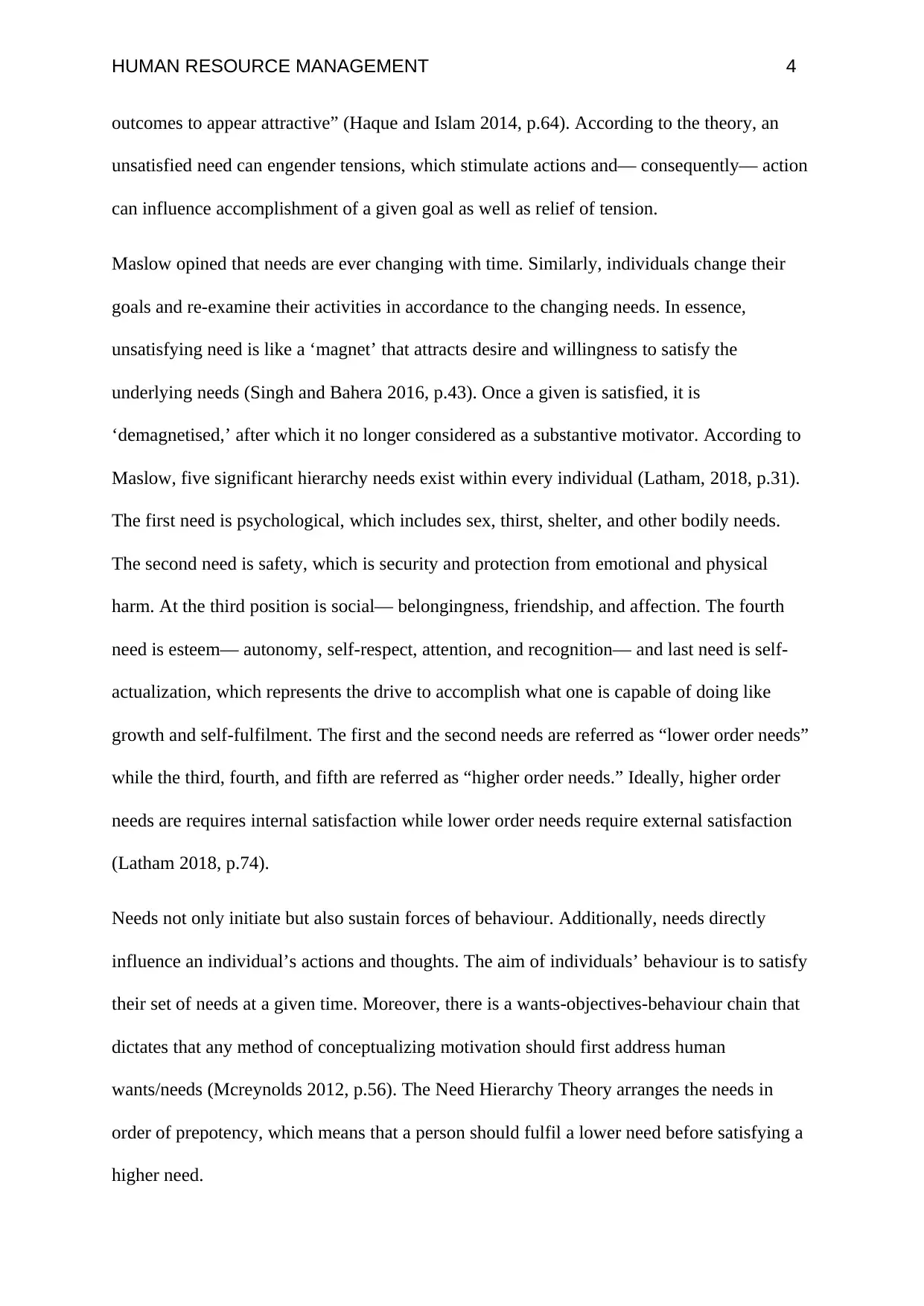
HUMAN RESOURCE MANAGEMENT 4
outcomes to appear attractive” (Haque and Islam 2014, p.64). According to the theory, an
unsatisfied need can engender tensions, which stimulate actions and— consequently— action
can influence accomplishment of a given goal as well as relief of tension.
Maslow opined that needs are ever changing with time. Similarly, individuals change their
goals and re-examine their activities in accordance to the changing needs. In essence,
unsatisfying need is like a ‘magnet’ that attracts desire and willingness to satisfy the
underlying needs (Singh and Bahera 2016, p.43). Once a given is satisfied, it is
‘demagnetised,’ after which it no longer considered as a substantive motivator. According to
Maslow, five significant hierarchy needs exist within every individual (Latham, 2018, p.31).
The first need is psychological, which includes sex, thirst, shelter, and other bodily needs.
The second need is safety, which is security and protection from emotional and physical
harm. At the third position is social— belongingness, friendship, and affection. The fourth
need is esteem— autonomy, self-respect, attention, and recognition— and last need is self-
actualization, which represents the drive to accomplish what one is capable of doing like
growth and self-fulfilment. The first and the second needs are referred as “lower order needs”
while the third, fourth, and fifth are referred as “higher order needs.” Ideally, higher order
needs are requires internal satisfaction while lower order needs require external satisfaction
(Latham 2018, p.74).
Needs not only initiate but also sustain forces of behaviour. Additionally, needs directly
influence an individual’s actions and thoughts. The aim of individuals’ behaviour is to satisfy
their set of needs at a given time. Moreover, there is a wants-objectives-behaviour chain that
dictates that any method of conceptualizing motivation should first address human
wants/needs (Mcreynolds 2012, p.56). The Need Hierarchy Theory arranges the needs in
order of prepotency, which means that a person should fulfil a lower need before satisfying a
higher need.
outcomes to appear attractive” (Haque and Islam 2014, p.64). According to the theory, an
unsatisfied need can engender tensions, which stimulate actions and— consequently— action
can influence accomplishment of a given goal as well as relief of tension.
Maslow opined that needs are ever changing with time. Similarly, individuals change their
goals and re-examine their activities in accordance to the changing needs. In essence,
unsatisfying need is like a ‘magnet’ that attracts desire and willingness to satisfy the
underlying needs (Singh and Bahera 2016, p.43). Once a given is satisfied, it is
‘demagnetised,’ after which it no longer considered as a substantive motivator. According to
Maslow, five significant hierarchy needs exist within every individual (Latham, 2018, p.31).
The first need is psychological, which includes sex, thirst, shelter, and other bodily needs.
The second need is safety, which is security and protection from emotional and physical
harm. At the third position is social— belongingness, friendship, and affection. The fourth
need is esteem— autonomy, self-respect, attention, and recognition— and last need is self-
actualization, which represents the drive to accomplish what one is capable of doing like
growth and self-fulfilment. The first and the second needs are referred as “lower order needs”
while the third, fourth, and fifth are referred as “higher order needs.” Ideally, higher order
needs are requires internal satisfaction while lower order needs require external satisfaction
(Latham 2018, p.74).
Needs not only initiate but also sustain forces of behaviour. Additionally, needs directly
influence an individual’s actions and thoughts. The aim of individuals’ behaviour is to satisfy
their set of needs at a given time. Moreover, there is a wants-objectives-behaviour chain that
dictates that any method of conceptualizing motivation should first address human
wants/needs (Mcreynolds 2012, p.56). The Need Hierarchy Theory arranges the needs in
order of prepotency, which means that a person should fulfil a lower need before satisfying a
higher need.
Secure Best Marks with AI Grader
Need help grading? Try our AI Grader for instant feedback on your assignments.
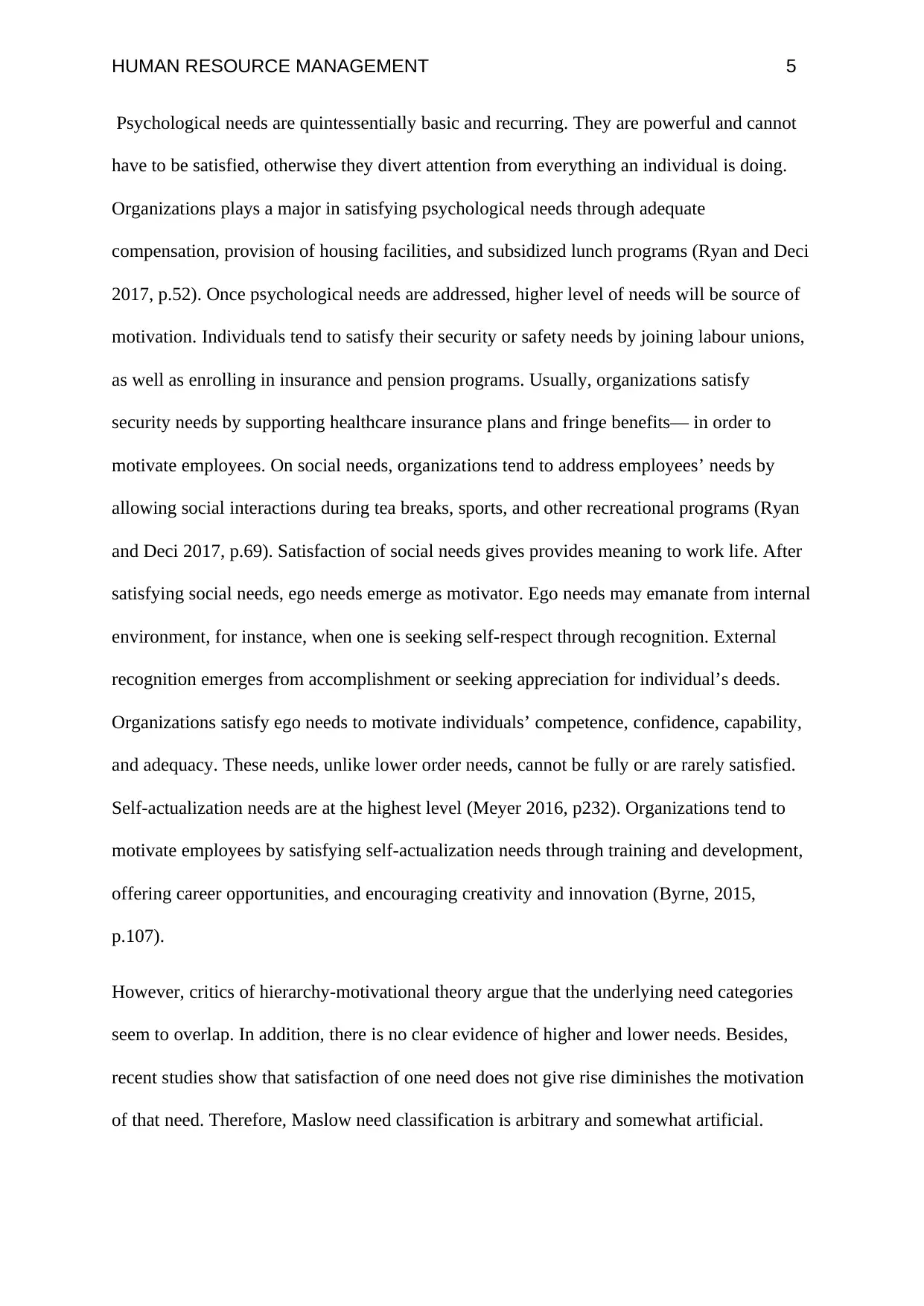
HUMAN RESOURCE MANAGEMENT 5
Psychological needs are quintessentially basic and recurring. They are powerful and cannot
have to be satisfied, otherwise they divert attention from everything an individual is doing.
Organizations plays a major in satisfying psychological needs through adequate
compensation, provision of housing facilities, and subsidized lunch programs (Ryan and Deci
2017, p.52). Once psychological needs are addressed, higher level of needs will be source of
motivation. Individuals tend to satisfy their security or safety needs by joining labour unions,
as well as enrolling in insurance and pension programs. Usually, organizations satisfy
security needs by supporting healthcare insurance plans and fringe benefits— in order to
motivate employees. On social needs, organizations tend to address employees’ needs by
allowing social interactions during tea breaks, sports, and other recreational programs (Ryan
and Deci 2017, p.69). Satisfaction of social needs gives provides meaning to work life. After
satisfying social needs, ego needs emerge as motivator. Ego needs may emanate from internal
environment, for instance, when one is seeking self-respect through recognition. External
recognition emerges from accomplishment or seeking appreciation for individual’s deeds.
Organizations satisfy ego needs to motivate individuals’ competence, confidence, capability,
and adequacy. These needs, unlike lower order needs, cannot be fully or are rarely satisfied.
Self-actualization needs are at the highest level (Meyer 2016, p232). Organizations tend to
motivate employees by satisfying self-actualization needs through training and development,
offering career opportunities, and encouraging creativity and innovation (Byrne, 2015,
p.107).
However, critics of hierarchy-motivational theory argue that the underlying need categories
seem to overlap. In addition, there is no clear evidence of higher and lower needs. Besides,
recent studies show that satisfaction of one need does not give rise diminishes the motivation
of that need. Therefore, Maslow need classification is arbitrary and somewhat artificial.
Psychological needs are quintessentially basic and recurring. They are powerful and cannot
have to be satisfied, otherwise they divert attention from everything an individual is doing.
Organizations plays a major in satisfying psychological needs through adequate
compensation, provision of housing facilities, and subsidized lunch programs (Ryan and Deci
2017, p.52). Once psychological needs are addressed, higher level of needs will be source of
motivation. Individuals tend to satisfy their security or safety needs by joining labour unions,
as well as enrolling in insurance and pension programs. Usually, organizations satisfy
security needs by supporting healthcare insurance plans and fringe benefits— in order to
motivate employees. On social needs, organizations tend to address employees’ needs by
allowing social interactions during tea breaks, sports, and other recreational programs (Ryan
and Deci 2017, p.69). Satisfaction of social needs gives provides meaning to work life. After
satisfying social needs, ego needs emerge as motivator. Ego needs may emanate from internal
environment, for instance, when one is seeking self-respect through recognition. External
recognition emerges from accomplishment or seeking appreciation for individual’s deeds.
Organizations satisfy ego needs to motivate individuals’ competence, confidence, capability,
and adequacy. These needs, unlike lower order needs, cannot be fully or are rarely satisfied.
Self-actualization needs are at the highest level (Meyer 2016, p232). Organizations tend to
motivate employees by satisfying self-actualization needs through training and development,
offering career opportunities, and encouraging creativity and innovation (Byrne, 2015,
p.107).
However, critics of hierarchy-motivational theory argue that the underlying need categories
seem to overlap. In addition, there is no clear evidence of higher and lower needs. Besides,
recent studies show that satisfaction of one need does not give rise diminishes the motivation
of that need. Therefore, Maslow need classification is arbitrary and somewhat artificial.
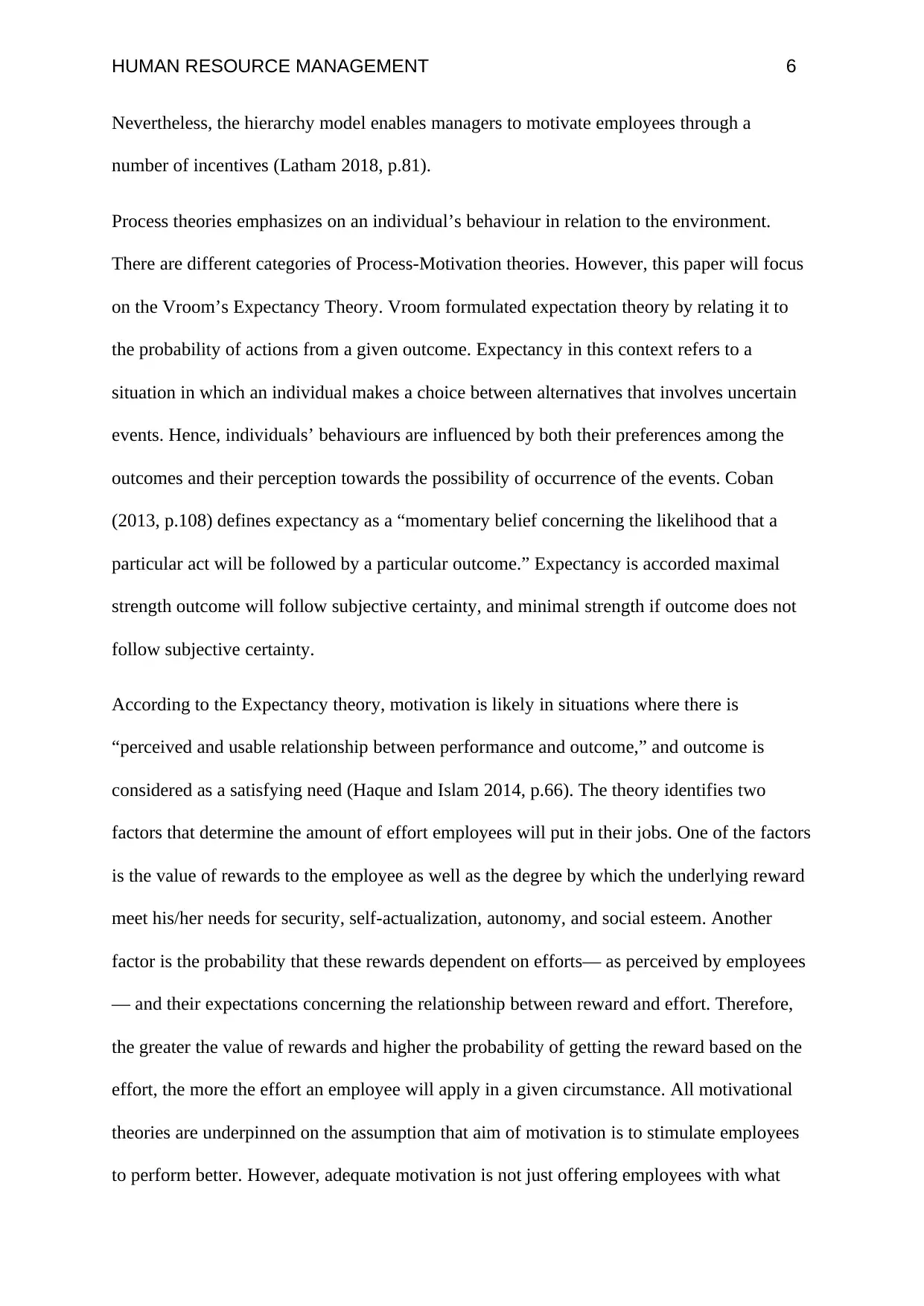
HUMAN RESOURCE MANAGEMENT 6
Nevertheless, the hierarchy model enables managers to motivate employees through a
number of incentives (Latham 2018, p.81).
Process theories emphasizes on an individual’s behaviour in relation to the environment.
There are different categories of Process-Motivation theories. However, this paper will focus
on the Vroom’s Expectancy Theory. Vroom formulated expectation theory by relating it to
the probability of actions from a given outcome. Expectancy in this context refers to a
situation in which an individual makes a choice between alternatives that involves uncertain
events. Hence, individuals’ behaviours are influenced by both their preferences among the
outcomes and their perception towards the possibility of occurrence of the events. Coban
(2013, p.108) defines expectancy as a “momentary belief concerning the likelihood that a
particular act will be followed by a particular outcome.” Expectancy is accorded maximal
strength outcome will follow subjective certainty, and minimal strength if outcome does not
follow subjective certainty.
According to the Expectancy theory, motivation is likely in situations where there is
“perceived and usable relationship between performance and outcome,” and outcome is
considered as a satisfying need (Haque and Islam 2014, p.66). The theory identifies two
factors that determine the amount of effort employees will put in their jobs. One of the factors
is the value of rewards to the employee as well as the degree by which the underlying reward
meet his/her needs for security, self-actualization, autonomy, and social esteem. Another
factor is the probability that these rewards dependent on efforts— as perceived by employees
— and their expectations concerning the relationship between reward and effort. Therefore,
the greater the value of rewards and higher the probability of getting the reward based on the
effort, the more the effort an employee will apply in a given circumstance. All motivational
theories are underpinned on the assumption that aim of motivation is to stimulate employees
to perform better. However, adequate motivation is not just offering employees with what
Nevertheless, the hierarchy model enables managers to motivate employees through a
number of incentives (Latham 2018, p.81).
Process theories emphasizes on an individual’s behaviour in relation to the environment.
There are different categories of Process-Motivation theories. However, this paper will focus
on the Vroom’s Expectancy Theory. Vroom formulated expectation theory by relating it to
the probability of actions from a given outcome. Expectancy in this context refers to a
situation in which an individual makes a choice between alternatives that involves uncertain
events. Hence, individuals’ behaviours are influenced by both their preferences among the
outcomes and their perception towards the possibility of occurrence of the events. Coban
(2013, p.108) defines expectancy as a “momentary belief concerning the likelihood that a
particular act will be followed by a particular outcome.” Expectancy is accorded maximal
strength outcome will follow subjective certainty, and minimal strength if outcome does not
follow subjective certainty.
According to the Expectancy theory, motivation is likely in situations where there is
“perceived and usable relationship between performance and outcome,” and outcome is
considered as a satisfying need (Haque and Islam 2014, p.66). The theory identifies two
factors that determine the amount of effort employees will put in their jobs. One of the factors
is the value of rewards to the employee as well as the degree by which the underlying reward
meet his/her needs for security, self-actualization, autonomy, and social esteem. Another
factor is the probability that these rewards dependent on efforts— as perceived by employees
— and their expectations concerning the relationship between reward and effort. Therefore,
the greater the value of rewards and higher the probability of getting the reward based on the
effort, the more the effort an employee will apply in a given circumstance. All motivational
theories are underpinned on the assumption that aim of motivation is to stimulate employees
to perform better. However, adequate motivation is not just offering employees with what
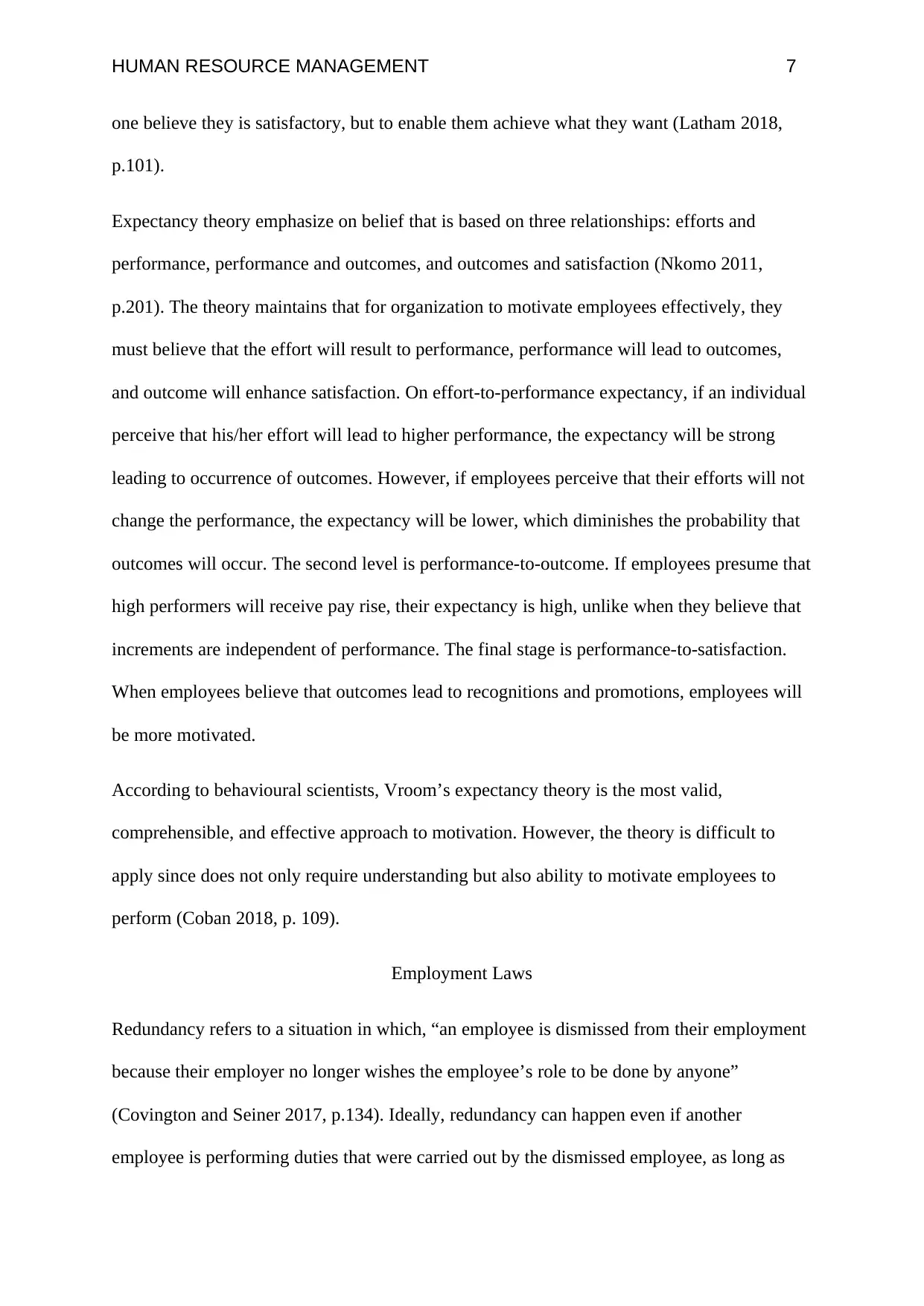
HUMAN RESOURCE MANAGEMENT 7
one believe they is satisfactory, but to enable them achieve what they want (Latham 2018,
p.101).
Expectancy theory emphasize on belief that is based on three relationships: efforts and
performance, performance and outcomes, and outcomes and satisfaction (Nkomo 2011,
p.201). The theory maintains that for organization to motivate employees effectively, they
must believe that the effort will result to performance, performance will lead to outcomes,
and outcome will enhance satisfaction. On effort-to-performance expectancy, if an individual
perceive that his/her effort will lead to higher performance, the expectancy will be strong
leading to occurrence of outcomes. However, if employees perceive that their efforts will not
change the performance, the expectancy will be lower, which diminishes the probability that
outcomes will occur. The second level is performance-to-outcome. If employees presume that
high performers will receive pay rise, their expectancy is high, unlike when they believe that
increments are independent of performance. The final stage is performance-to-satisfaction.
When employees believe that outcomes lead to recognitions and promotions, employees will
be more motivated.
According to behavioural scientists, Vroom’s expectancy theory is the most valid,
comprehensible, and effective approach to motivation. However, the theory is difficult to
apply since does not only require understanding but also ability to motivate employees to
perform (Coban 2018, p. 109).
Employment Laws
Redundancy refers to a situation in which, “an employee is dismissed from their employment
because their employer no longer wishes the employee’s role to be done by anyone”
(Covington and Seiner 2017, p.134). Ideally, redundancy can happen even if another
employee is performing duties that were carried out by the dismissed employee, as long as
one believe they is satisfactory, but to enable them achieve what they want (Latham 2018,
p.101).
Expectancy theory emphasize on belief that is based on three relationships: efforts and
performance, performance and outcomes, and outcomes and satisfaction (Nkomo 2011,
p.201). The theory maintains that for organization to motivate employees effectively, they
must believe that the effort will result to performance, performance will lead to outcomes,
and outcome will enhance satisfaction. On effort-to-performance expectancy, if an individual
perceive that his/her effort will lead to higher performance, the expectancy will be strong
leading to occurrence of outcomes. However, if employees perceive that their efforts will not
change the performance, the expectancy will be lower, which diminishes the probability that
outcomes will occur. The second level is performance-to-outcome. If employees presume that
high performers will receive pay rise, their expectancy is high, unlike when they believe that
increments are independent of performance. The final stage is performance-to-satisfaction.
When employees believe that outcomes lead to recognitions and promotions, employees will
be more motivated.
According to behavioural scientists, Vroom’s expectancy theory is the most valid,
comprehensible, and effective approach to motivation. However, the theory is difficult to
apply since does not only require understanding but also ability to motivate employees to
perform (Coban 2018, p. 109).
Employment Laws
Redundancy refers to a situation in which, “an employee is dismissed from their employment
because their employer no longer wishes the employee’s role to be done by anyone”
(Covington and Seiner 2017, p.134). Ideally, redundancy can happen even if another
employee is performing duties that were carried out by the dismissed employee, as long as
Paraphrase This Document
Need a fresh take? Get an instant paraphrase of this document with our AI Paraphraser
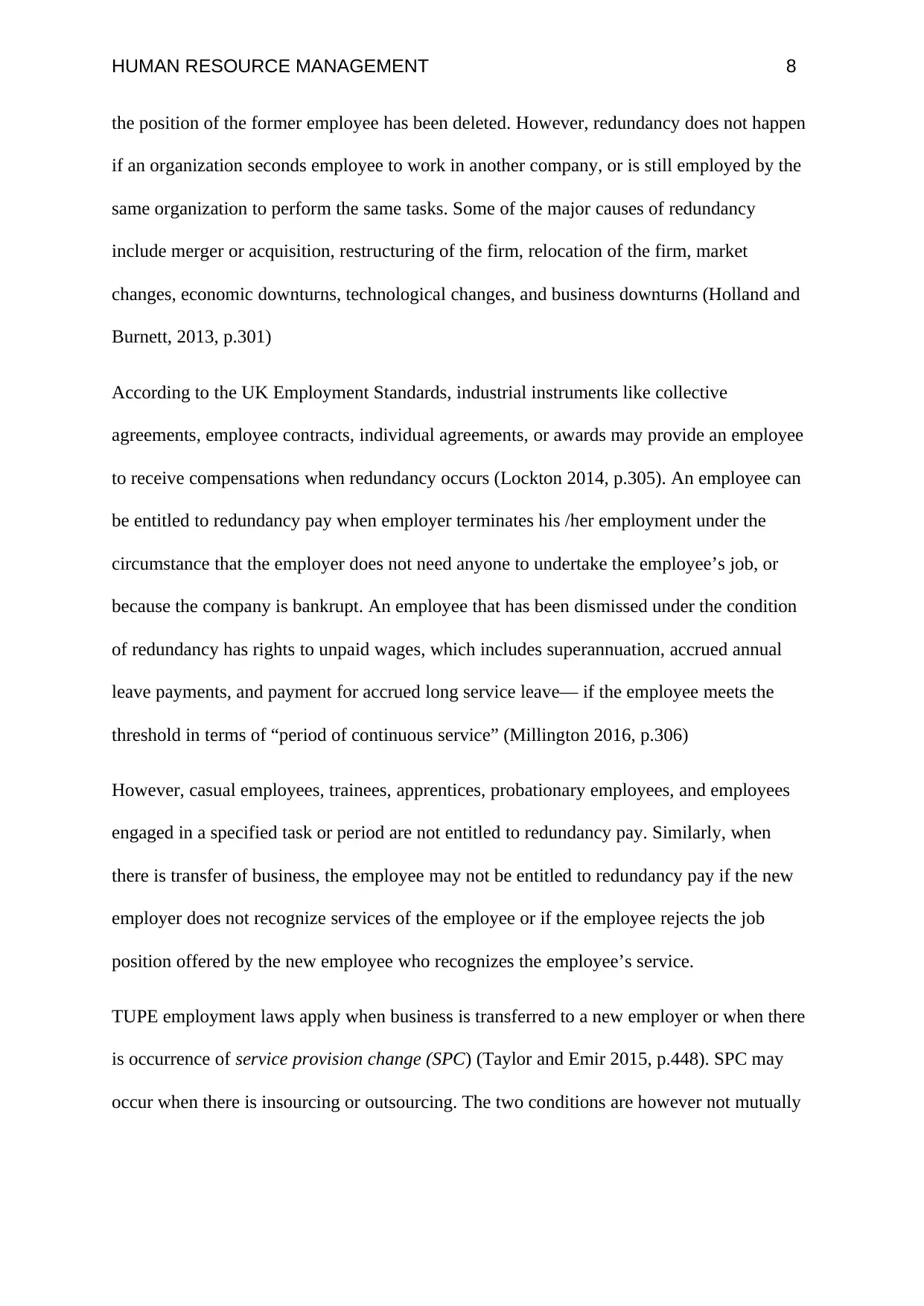
HUMAN RESOURCE MANAGEMENT 8
the position of the former employee has been deleted. However, redundancy does not happen
if an organization seconds employee to work in another company, or is still employed by the
same organization to perform the same tasks. Some of the major causes of redundancy
include merger or acquisition, restructuring of the firm, relocation of the firm, market
changes, economic downturns, technological changes, and business downturns (Holland and
Burnett, 2013, p.301)
According to the UK Employment Standards, industrial instruments like collective
agreements, employee contracts, individual agreements, or awards may provide an employee
to receive compensations when redundancy occurs (Lockton 2014, p.305). An employee can
be entitled to redundancy pay when employer terminates his /her employment under the
circumstance that the employer does not need anyone to undertake the employee’s job, or
because the company is bankrupt. An employee that has been dismissed under the condition
of redundancy has rights to unpaid wages, which includes superannuation, accrued annual
leave payments, and payment for accrued long service leave— if the employee meets the
threshold in terms of “period of continuous service” (Millington 2016, p.306)
However, casual employees, trainees, apprentices, probationary employees, and employees
engaged in a specified task or period are not entitled to redundancy pay. Similarly, when
there is transfer of business, the employee may not be entitled to redundancy pay if the new
employer does not recognize services of the employee or if the employee rejects the job
position offered by the new employee who recognizes the employee’s service.
TUPE employment laws apply when business is transferred to a new employer or when there
is occurrence of service provision change (SPC) (Taylor and Emir 2015, p.448). SPC may
occur when there is insourcing or outsourcing. The two conditions are however not mutually
the position of the former employee has been deleted. However, redundancy does not happen
if an organization seconds employee to work in another company, or is still employed by the
same organization to perform the same tasks. Some of the major causes of redundancy
include merger or acquisition, restructuring of the firm, relocation of the firm, market
changes, economic downturns, technological changes, and business downturns (Holland and
Burnett, 2013, p.301)
According to the UK Employment Standards, industrial instruments like collective
agreements, employee contracts, individual agreements, or awards may provide an employee
to receive compensations when redundancy occurs (Lockton 2014, p.305). An employee can
be entitled to redundancy pay when employer terminates his /her employment under the
circumstance that the employer does not need anyone to undertake the employee’s job, or
because the company is bankrupt. An employee that has been dismissed under the condition
of redundancy has rights to unpaid wages, which includes superannuation, accrued annual
leave payments, and payment for accrued long service leave— if the employee meets the
threshold in terms of “period of continuous service” (Millington 2016, p.306)
However, casual employees, trainees, apprentices, probationary employees, and employees
engaged in a specified task or period are not entitled to redundancy pay. Similarly, when
there is transfer of business, the employee may not be entitled to redundancy pay if the new
employer does not recognize services of the employee or if the employee rejects the job
position offered by the new employee who recognizes the employee’s service.
TUPE employment laws apply when business is transferred to a new employer or when there
is occurrence of service provision change (SPC) (Taylor and Emir 2015, p.448). SPC may
occur when there is insourcing or outsourcing. The two conditions are however not mutually
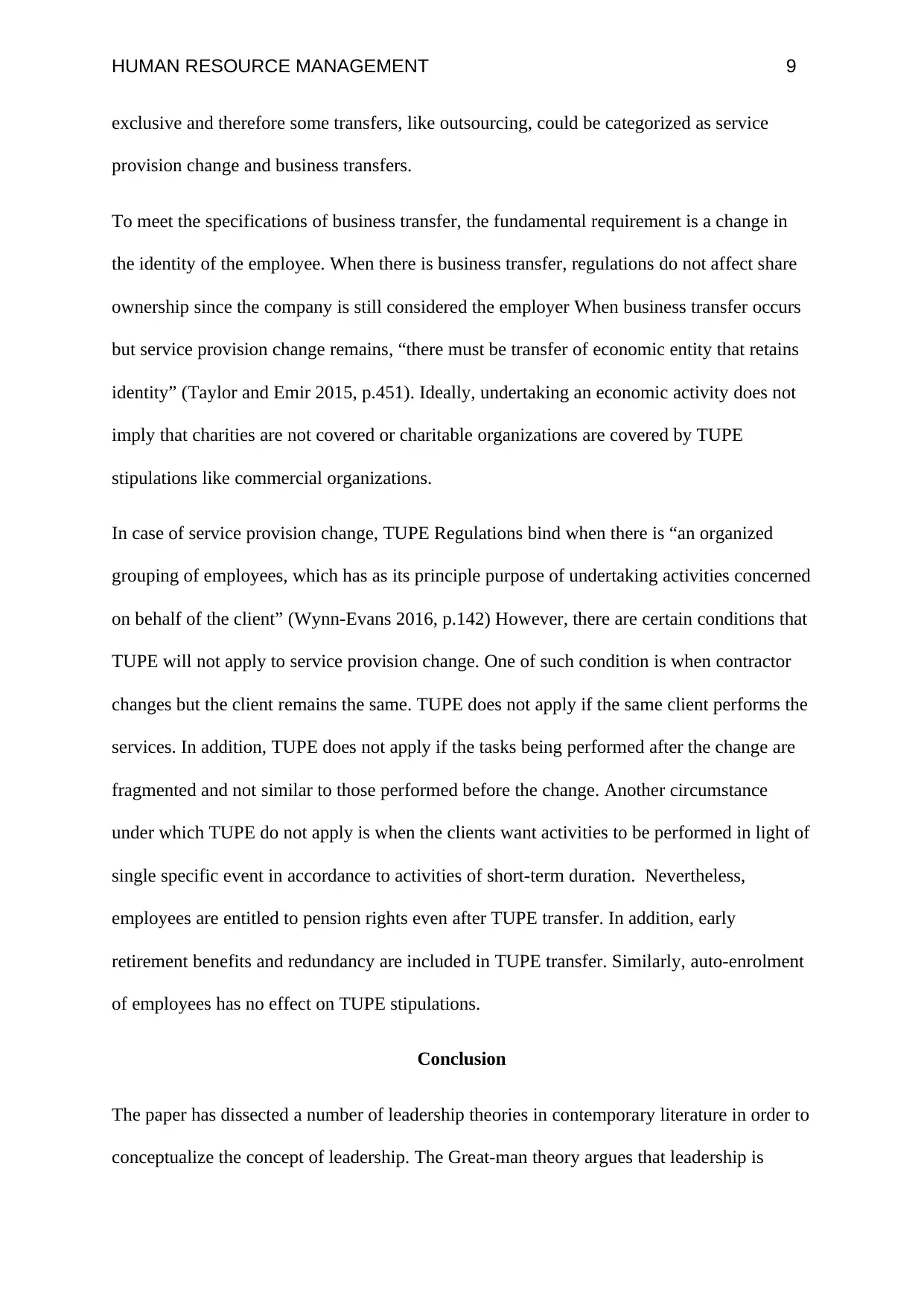
HUMAN RESOURCE MANAGEMENT 9
exclusive and therefore some transfers, like outsourcing, could be categorized as service
provision change and business transfers.
To meet the specifications of business transfer, the fundamental requirement is a change in
the identity of the employee. When there is business transfer, regulations do not affect share
ownership since the company is still considered the employer When business transfer occurs
but service provision change remains, “there must be transfer of economic entity that retains
identity” (Taylor and Emir 2015, p.451). Ideally, undertaking an economic activity does not
imply that charities are not covered or charitable organizations are covered by TUPE
stipulations like commercial organizations.
In case of service provision change, TUPE Regulations bind when there is “an organized
grouping of employees, which has as its principle purpose of undertaking activities concerned
on behalf of the client” (Wynn-Evans 2016, p.142) However, there are certain conditions that
TUPE will not apply to service provision change. One of such condition is when contractor
changes but the client remains the same. TUPE does not apply if the same client performs the
services. In addition, TUPE does not apply if the tasks being performed after the change are
fragmented and not similar to those performed before the change. Another circumstance
under which TUPE do not apply is when the clients want activities to be performed in light of
single specific event in accordance to activities of short-term duration. Nevertheless,
employees are entitled to pension rights even after TUPE transfer. In addition, early
retirement benefits and redundancy are included in TUPE transfer. Similarly, auto-enrolment
of employees has no effect on TUPE stipulations.
Conclusion
The paper has dissected a number of leadership theories in contemporary literature in order to
conceptualize the concept of leadership. The Great-man theory argues that leadership is
exclusive and therefore some transfers, like outsourcing, could be categorized as service
provision change and business transfers.
To meet the specifications of business transfer, the fundamental requirement is a change in
the identity of the employee. When there is business transfer, regulations do not affect share
ownership since the company is still considered the employer When business transfer occurs
but service provision change remains, “there must be transfer of economic entity that retains
identity” (Taylor and Emir 2015, p.451). Ideally, undertaking an economic activity does not
imply that charities are not covered or charitable organizations are covered by TUPE
stipulations like commercial organizations.
In case of service provision change, TUPE Regulations bind when there is “an organized
grouping of employees, which has as its principle purpose of undertaking activities concerned
on behalf of the client” (Wynn-Evans 2016, p.142) However, there are certain conditions that
TUPE will not apply to service provision change. One of such condition is when contractor
changes but the client remains the same. TUPE does not apply if the same client performs the
services. In addition, TUPE does not apply if the tasks being performed after the change are
fragmented and not similar to those performed before the change. Another circumstance
under which TUPE do not apply is when the clients want activities to be performed in light of
single specific event in accordance to activities of short-term duration. Nevertheless,
employees are entitled to pension rights even after TUPE transfer. In addition, early
retirement benefits and redundancy are included in TUPE transfer. Similarly, auto-enrolment
of employees has no effect on TUPE stipulations.
Conclusion
The paper has dissected a number of leadership theories in contemporary literature in order to
conceptualize the concept of leadership. The Great-man theory argues that leadership is
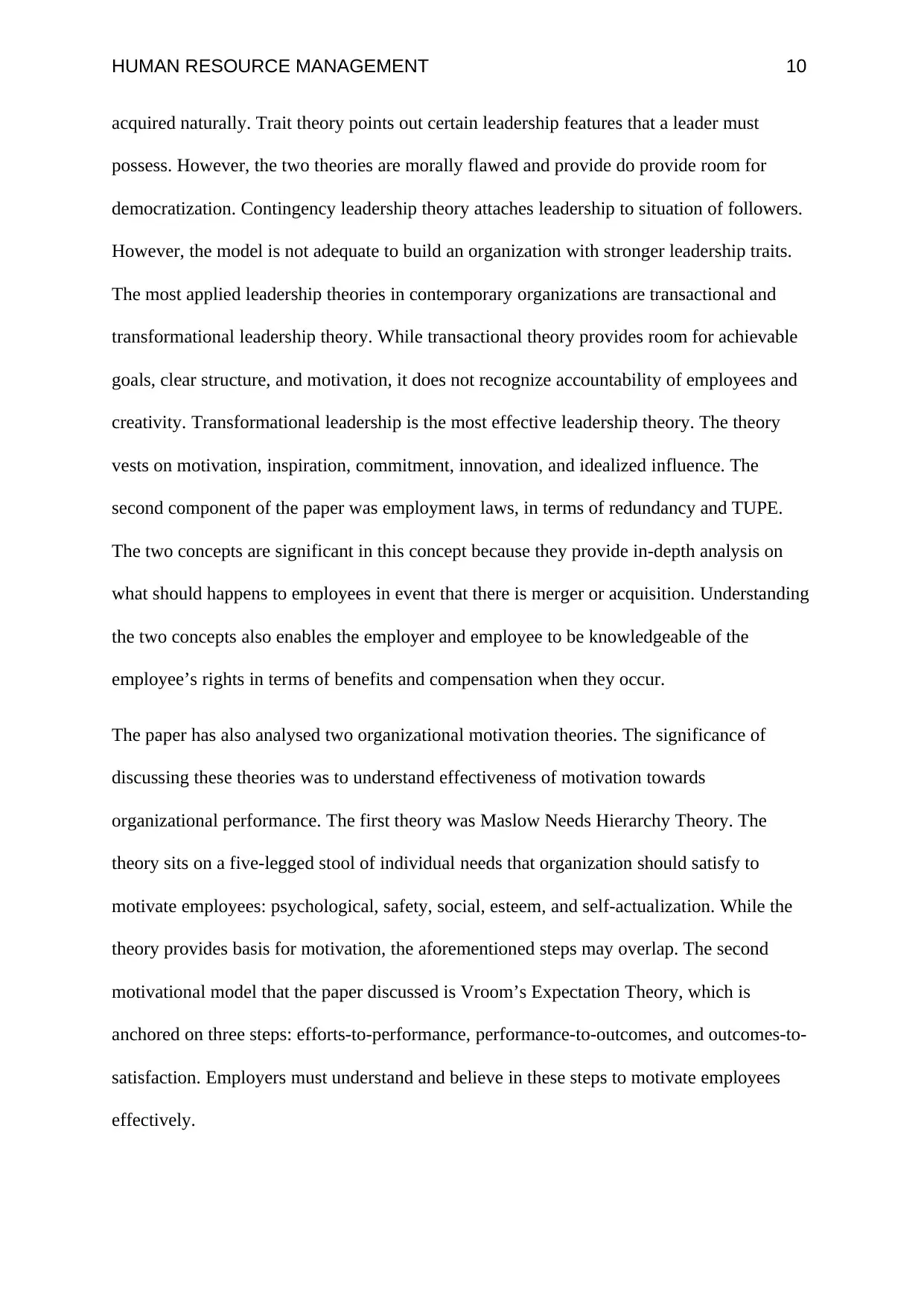
HUMAN RESOURCE MANAGEMENT 10
acquired naturally. Trait theory points out certain leadership features that a leader must
possess. However, the two theories are morally flawed and provide do provide room for
democratization. Contingency leadership theory attaches leadership to situation of followers.
However, the model is not adequate to build an organization with stronger leadership traits.
The most applied leadership theories in contemporary organizations are transactional and
transformational leadership theory. While transactional theory provides room for achievable
goals, clear structure, and motivation, it does not recognize accountability of employees and
creativity. Transformational leadership is the most effective leadership theory. The theory
vests on motivation, inspiration, commitment, innovation, and idealized influence. The
second component of the paper was employment laws, in terms of redundancy and TUPE.
The two concepts are significant in this concept because they provide in-depth analysis on
what should happens to employees in event that there is merger or acquisition. Understanding
the two concepts also enables the employer and employee to be knowledgeable of the
employee’s rights in terms of benefits and compensation when they occur.
The paper has also analysed two organizational motivation theories. The significance of
discussing these theories was to understand effectiveness of motivation towards
organizational performance. The first theory was Maslow Needs Hierarchy Theory. The
theory sits on a five-legged stool of individual needs that organization should satisfy to
motivate employees: psychological, safety, social, esteem, and self-actualization. While the
theory provides basis for motivation, the aforementioned steps may overlap. The second
motivational model that the paper discussed is Vroom’s Expectation Theory, which is
anchored on three steps: efforts-to-performance, performance-to-outcomes, and outcomes-to-
satisfaction. Employers must understand and believe in these steps to motivate employees
effectively.
acquired naturally. Trait theory points out certain leadership features that a leader must
possess. However, the two theories are morally flawed and provide do provide room for
democratization. Contingency leadership theory attaches leadership to situation of followers.
However, the model is not adequate to build an organization with stronger leadership traits.
The most applied leadership theories in contemporary organizations are transactional and
transformational leadership theory. While transactional theory provides room for achievable
goals, clear structure, and motivation, it does not recognize accountability of employees and
creativity. Transformational leadership is the most effective leadership theory. The theory
vests on motivation, inspiration, commitment, innovation, and idealized influence. The
second component of the paper was employment laws, in terms of redundancy and TUPE.
The two concepts are significant in this concept because they provide in-depth analysis on
what should happens to employees in event that there is merger or acquisition. Understanding
the two concepts also enables the employer and employee to be knowledgeable of the
employee’s rights in terms of benefits and compensation when they occur.
The paper has also analysed two organizational motivation theories. The significance of
discussing these theories was to understand effectiveness of motivation towards
organizational performance. The first theory was Maslow Needs Hierarchy Theory. The
theory sits on a five-legged stool of individual needs that organization should satisfy to
motivate employees: psychological, safety, social, esteem, and self-actualization. While the
theory provides basis for motivation, the aforementioned steps may overlap. The second
motivational model that the paper discussed is Vroom’s Expectation Theory, which is
anchored on three steps: efforts-to-performance, performance-to-outcomes, and outcomes-to-
satisfaction. Employers must understand and believe in these steps to motivate employees
effectively.
Secure Best Marks with AI Grader
Need help grading? Try our AI Grader for instant feedback on your assignments.
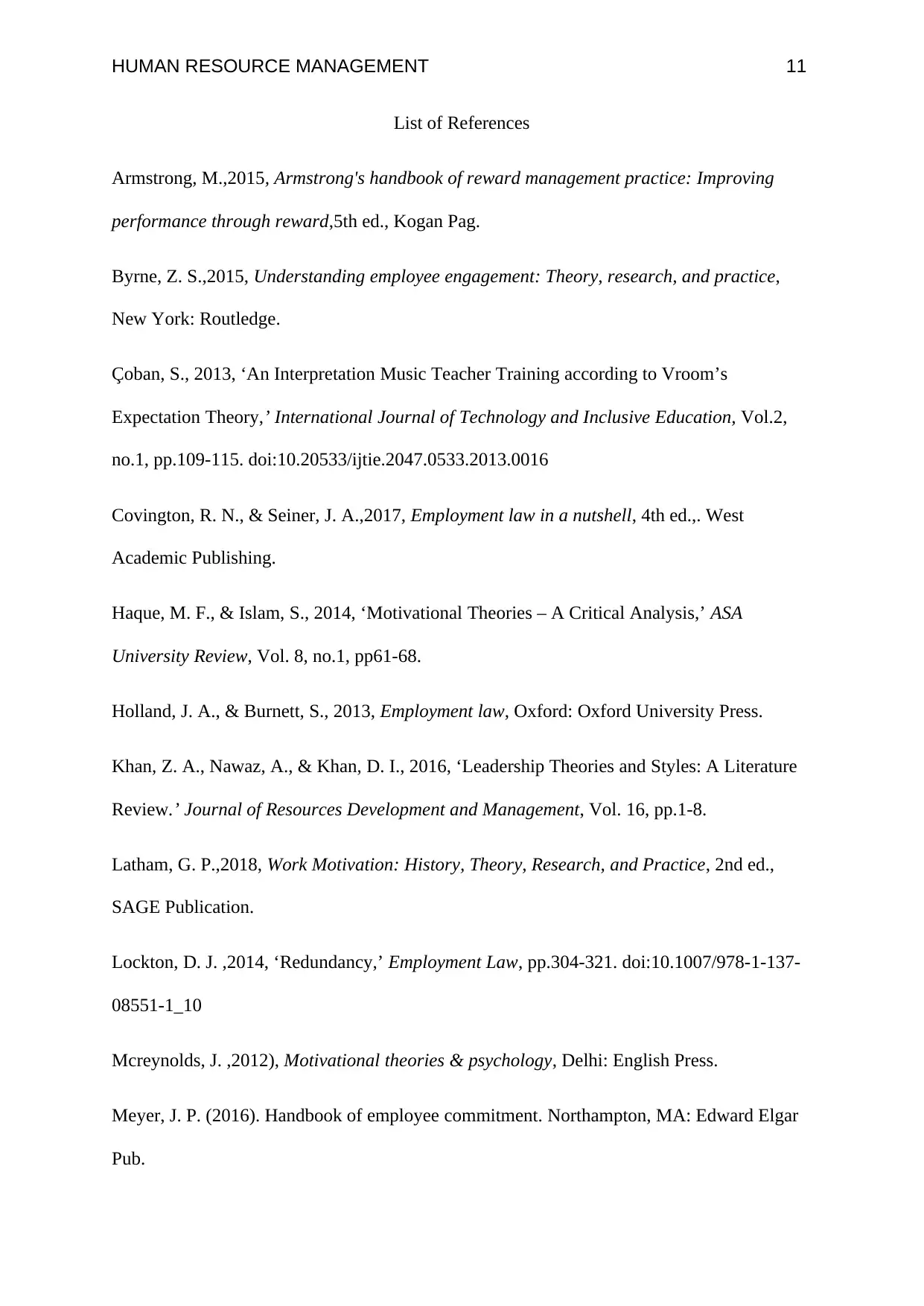
HUMAN RESOURCE MANAGEMENT 11
List of References
Armstrong, M.,2015, Armstrong's handbook of reward management practice: Improving
performance through reward,5th ed., Kogan Pag.
Byrne, Z. S.,2015, Understanding employee engagement: Theory, research, and practice,
New York: Routledge.
Çoban, S., 2013, ‘An Interpretation Music Teacher Training according to Vroom’s
Expectation Theory,’ International Journal of Technology and Inclusive Education, Vol.2,
no.1, pp.109-115. doi:10.20533/ijtie.2047.0533.2013.0016
Covington, R. N., & Seiner, J. A.,2017, Employment law in a nutshell, 4th ed.,. West
Academic Publishing.
Haque, M. F., & Islam, S., 2014, ‘Motivational Theories – A Critical Analysis,’ ASA
University Review, Vol. 8, no.1, pp61-68.
Holland, J. A., & Burnett, S., 2013, Employment law, Oxford: Oxford University Press.
Khan, Z. A., Nawaz, A., & Khan, D. I., 2016, ‘Leadership Theories and Styles: A Literature
Review.’ Journal of Resources Development and Management, Vol. 16, pp.1-8.
Latham, G. P.,2018, Work Motivation: History, Theory, Research, and Practice, 2nd ed.,
SAGE Publication.
Lockton, D. J. ,2014, ‘Redundancy,’ Employment Law, pp.304-321. doi:10.1007/978-1-137-
08551-1_10
Mcreynolds, J. ,2012), Motivational theories & psychology, Delhi: English Press.
Meyer, J. P. (2016). Handbook of employee commitment. Northampton, MA: Edward Elgar
Pub.
List of References
Armstrong, M.,2015, Armstrong's handbook of reward management practice: Improving
performance through reward,5th ed., Kogan Pag.
Byrne, Z. S.,2015, Understanding employee engagement: Theory, research, and practice,
New York: Routledge.
Çoban, S., 2013, ‘An Interpretation Music Teacher Training according to Vroom’s
Expectation Theory,’ International Journal of Technology and Inclusive Education, Vol.2,
no.1, pp.109-115. doi:10.20533/ijtie.2047.0533.2013.0016
Covington, R. N., & Seiner, J. A.,2017, Employment law in a nutshell, 4th ed.,. West
Academic Publishing.
Haque, M. F., & Islam, S., 2014, ‘Motivational Theories – A Critical Analysis,’ ASA
University Review, Vol. 8, no.1, pp61-68.
Holland, J. A., & Burnett, S., 2013, Employment law, Oxford: Oxford University Press.
Khan, Z. A., Nawaz, A., & Khan, D. I., 2016, ‘Leadership Theories and Styles: A Literature
Review.’ Journal of Resources Development and Management, Vol. 16, pp.1-8.
Latham, G. P.,2018, Work Motivation: History, Theory, Research, and Practice, 2nd ed.,
SAGE Publication.
Lockton, D. J. ,2014, ‘Redundancy,’ Employment Law, pp.304-321. doi:10.1007/978-1-137-
08551-1_10
Mcreynolds, J. ,2012), Motivational theories & psychology, Delhi: English Press.
Meyer, J. P. (2016). Handbook of employee commitment. Northampton, MA: Edward Elgar
Pub.
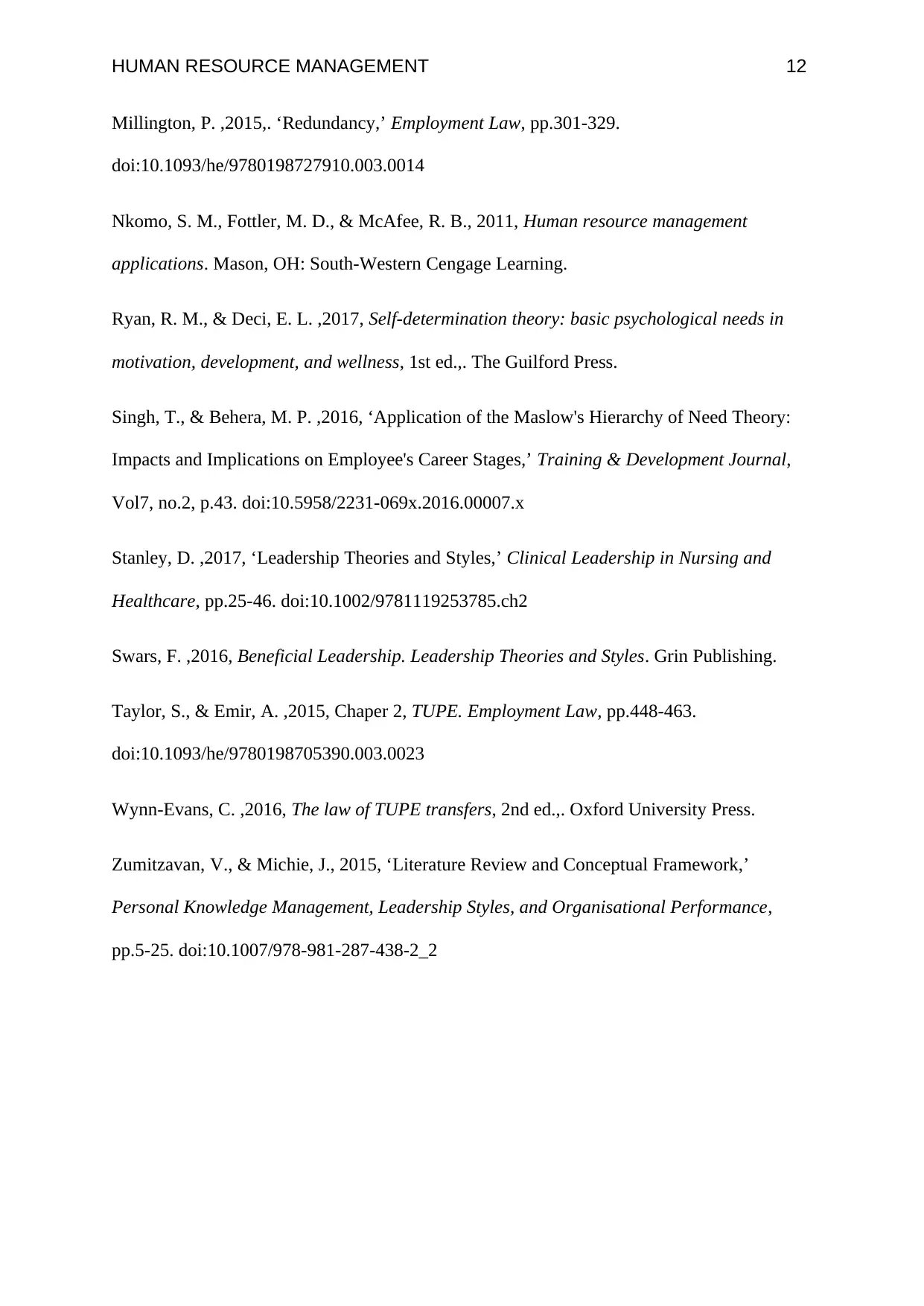
HUMAN RESOURCE MANAGEMENT 12
Millington, P. ,2015,. ‘Redundancy,’ Employment Law, pp.301-329.
doi:10.1093/he/9780198727910.003.0014
Nkomo, S. M., Fottler, M. D., & McAfee, R. B., 2011, Human resource management
applications. Mason, OH: South-Western Cengage Learning.
Ryan, R. M., & Deci, E. L. ,2017, Self-determination theory: basic psychological needs in
motivation, development, and wellness, 1st ed.,. The Guilford Press.
Singh, T., & Behera, M. P. ,2016, ‘Application of the Maslow's Hierarchy of Need Theory:
Impacts and Implications on Employee's Career Stages,’ Training & Development Journal,
Vol7, no.2, p.43. doi:10.5958/2231-069x.2016.00007.x
Stanley, D. ,2017, ‘Leadership Theories and Styles,’ Clinical Leadership in Nursing and
Healthcare, pp.25-46. doi:10.1002/9781119253785.ch2
Swars, F. ,2016, Beneficial Leadership. Leadership Theories and Styles. Grin Publishing.
Taylor, S., & Emir, A. ,2015, Chaper 2, TUPE. Employment Law, pp.448-463.
doi:10.1093/he/9780198705390.003.0023
Wynn-Evans, C. ,2016, The law of TUPE transfers, 2nd ed.,. Oxford University Press.
Zumitzavan, V., & Michie, J., 2015, ‘Literature Review and Conceptual Framework,’
Personal Knowledge Management, Leadership Styles, and Organisational Performance,
pp.5-25. doi:10.1007/978-981-287-438-2_2
Millington, P. ,2015,. ‘Redundancy,’ Employment Law, pp.301-329.
doi:10.1093/he/9780198727910.003.0014
Nkomo, S. M., Fottler, M. D., & McAfee, R. B., 2011, Human resource management
applications. Mason, OH: South-Western Cengage Learning.
Ryan, R. M., & Deci, E. L. ,2017, Self-determination theory: basic psychological needs in
motivation, development, and wellness, 1st ed.,. The Guilford Press.
Singh, T., & Behera, M. P. ,2016, ‘Application of the Maslow's Hierarchy of Need Theory:
Impacts and Implications on Employee's Career Stages,’ Training & Development Journal,
Vol7, no.2, p.43. doi:10.5958/2231-069x.2016.00007.x
Stanley, D. ,2017, ‘Leadership Theories and Styles,’ Clinical Leadership in Nursing and
Healthcare, pp.25-46. doi:10.1002/9781119253785.ch2
Swars, F. ,2016, Beneficial Leadership. Leadership Theories and Styles. Grin Publishing.
Taylor, S., & Emir, A. ,2015, Chaper 2, TUPE. Employment Law, pp.448-463.
doi:10.1093/he/9780198705390.003.0023
Wynn-Evans, C. ,2016, The law of TUPE transfers, 2nd ed.,. Oxford University Press.
Zumitzavan, V., & Michie, J., 2015, ‘Literature Review and Conceptual Framework,’
Personal Knowledge Management, Leadership Styles, and Organisational Performance,
pp.5-25. doi:10.1007/978-981-287-438-2_2
1 out of 12
Your All-in-One AI-Powered Toolkit for Academic Success.
+13062052269
info@desklib.com
Available 24*7 on WhatsApp / Email
![[object Object]](/_next/static/media/star-bottom.7253800d.svg)
Unlock your academic potential
© 2024 | Zucol Services PVT LTD | All rights reserved.


